Museum of the Cold War at Prague’s Hotel Jalta
By Tracy A. Burns
The big secret
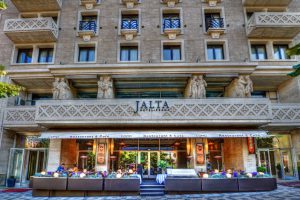 From the 1950s until 1989, the five-star boutique Hotel Jalta, recognized by UNESCO, harbored a big secret: About 20 meters under the hotel, there was an anti-nuclear bunker spread over three floors. Built from 1954 to 1958 to hold 150 people, the bunker was slated to provide shelter for prominent officials and distinguished officers for as long as two months if war broke out. The Military of Defense owned the bunker until it was declassified in 1997. Now it is the property of the hotel and has been turned into a museum with displays focusing on the Cold War.
From the 1950s until 1989, the five-star boutique Hotel Jalta, recognized by UNESCO, harbored a big secret: About 20 meters under the hotel, there was an anti-nuclear bunker spread over three floors. Built from 1954 to 1958 to hold 150 people, the bunker was slated to provide shelter for prominent officials and distinguished officers for as long as two months if war broke out. The Military of Defense owned the bunker until it was declassified in 1997. Now it is the property of the hotel and has been turned into a museum with displays focusing on the Cold War.
The Secret Police’s role
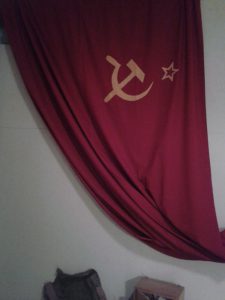 The Hotel Jalta, an example of socialist architecture, was erected from 1954 to 1958 on the site of a residential building that had been bombed by Allied Forces at the end of the war. The structure was commissioned by then Czechoslovak President Antonin Zapotocky, who helped plan the project. The underground rooms were never used as an anti-nuclear bunker because no war erupted, but their history is intriguing. The Secret Police occupied the vast space for four decades. They created a listening post to eavesdrop on the hotel’s guests, who were predominantly from Western countries, as well as on the hotel’s employees. When Western Germany’s embassy was situated on the premises in the 1970s, the Secret Police tapped their phones and bugged their offices, too. Bugs in the hotel rooms were creatively placed. For example, they could be found on shoebrushes. People who worked at the hotel were not allowed to enter the underground rooms.
The Hotel Jalta, an example of socialist architecture, was erected from 1954 to 1958 on the site of a residential building that had been bombed by Allied Forces at the end of the war. The structure was commissioned by then Czechoslovak President Antonin Zapotocky, who helped plan the project. The underground rooms were never used as an anti-nuclear bunker because no war erupted, but their history is intriguing. The Secret Police occupied the vast space for four decades. They created a listening post to eavesdrop on the hotel’s guests, who were predominantly from Western countries, as well as on the hotel’s employees. When Western Germany’s embassy was situated on the premises in the 1970s, the Secret Police tapped their phones and bugged their offices, too. Bugs in the hotel rooms were creatively placed. For example, they could be found on shoebrushes. People who worked at the hotel were not allowed to enter the underground rooms.
The interior of the bunker
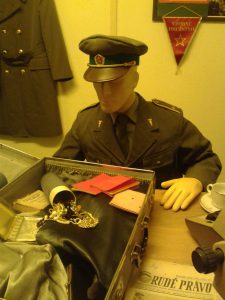 The bunker was well-equipped with an operating room in which 15 doctors could work at the same time, though this part of the structure is not currently open to the public. It also had its own power and water supply that included a special cistern that could hold up to 53 cubic liters of water. The concrete walls were two meters thick with a steel slab to protect against external sources of radiation. Two emergency exits led to Wenceslas Square and an adjacent building.
The bunker was well-equipped with an operating room in which 15 doctors could work at the same time, though this part of the structure is not currently open to the public. It also had its own power and water supply that included a special cistern that could hold up to 53 cubic liters of water. The concrete walls were two meters thick with a steel slab to protect against external sources of radiation. Two emergency exits led to Wenceslas Square and an adjacent building.
The museum
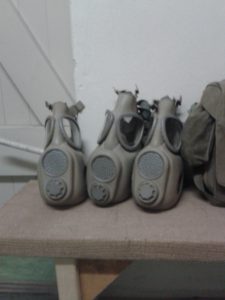 Now several underground rooms have been turned into the Museum of the Cold War, where visitors are greeted by their guide, a man dressed in the uniform of a Czechoslovak army officer during the 1980s. The curious can see the listening devices of the Secret Police and the facilities of the bunker. The workings of a large switchboard used to eavesdrop on conversations are explained in detail. A telex is on display, too. Visitors will also see gas masks, Communist-era newspapers, numerous border control officers’ uniforms, and a 1950s-era machine gun that they can actually hold. A mannequin dressed as a border control official during the 1950s appears to be inspecting a guest’s suitcase containing jewelry that was smuggled into Czechoslovakia.
Now several underground rooms have been turned into the Museum of the Cold War, where visitors are greeted by their guide, a man dressed in the uniform of a Czechoslovak army officer during the 1980s. The curious can see the listening devices of the Secret Police and the facilities of the bunker. The workings of a large switchboard used to eavesdrop on conversations are explained in detail. A telex is on display, too. Visitors will also see gas masks, Communist-era newspapers, numerous border control officers’ uniforms, and a 1950s-era machine gun that they can actually hold. A mannequin dressed as a border control official during the 1950s appears to be inspecting a guest’s suitcase containing jewelry that was smuggled into Czechoslovakia.
More about the exhibition
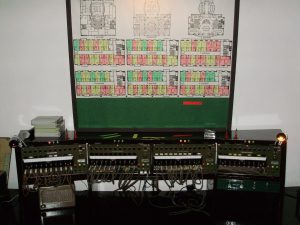 The beginning of the exhibition displays Communist propaganda about former Czechoslovakia throughout the former country’s dark decades. Communist presidents have their own places in the exhibition: A red socialist banner features Zapotocky, the country’s leader during the Stalinist 1950s, while other portraits show Klement Gottwald and Gustav Husak. Gottwald, the first Communist president of Czechoslovakia and a prominent player in the Communist Coup of February 1948, initiated a series of purges against nonCommunists as well as Communists. Husak represented the former country during the harsh normalization period following the Soviet invasion that destroyed the liberal reforms of the 1968 Prague Spring. Under his firm grip for two decades, Czechoslovakia remained loyal to the Russians. Copies of totalitarian posters on one wall announce the 15th anniversary of the Pioneers, a Soviet-style Czechoslovak youth organization, for example. Porcelain is decorated with the Secret Police logo. The history of the hotel is well documented, too. The exhibition allows the public not only to become familiar with the use of the underground bunker during the totalitarian era but also to gain insight into the era of the Cold War itself.
The beginning of the exhibition displays Communist propaganda about former Czechoslovakia throughout the former country’s dark decades. Communist presidents have their own places in the exhibition: A red socialist banner features Zapotocky, the country’s leader during the Stalinist 1950s, while other portraits show Klement Gottwald and Gustav Husak. Gottwald, the first Communist president of Czechoslovakia and a prominent player in the Communist Coup of February 1948, initiated a series of purges against nonCommunists as well as Communists. Husak represented the former country during the harsh normalization period following the Soviet invasion that destroyed the liberal reforms of the 1968 Prague Spring. Under his firm grip for two decades, Czechoslovakia remained loyal to the Russians. Copies of totalitarian posters on one wall announce the 15th anniversary of the Pioneers, a Soviet-style Czechoslovak youth organization, for example. Porcelain is decorated with the Secret Police logo. The history of the hotel is well documented, too. The exhibition allows the public not only to become familiar with the use of the underground bunker during the totalitarian era but also to gain insight into the era of the Cold War itself.
Opening times and other information
The museum’s opening times alternate between Mondays and Wednesdays and Tuesdays and Thursdays, always from 5 pm to 8 pm. A maximum of seven people can go on the 30-minute tour that costs 75 Czech crowns. Tours are in Czech. English speakers are given a text which describes all the exhibits. It is necessary to book a tour in advance.
Hotel Jalta, Vaclavske namesti 45, Praha 1, Tel: 222 822 111, Website: www.hoteljalta.com, Email: concierge@hoteljalta.com



